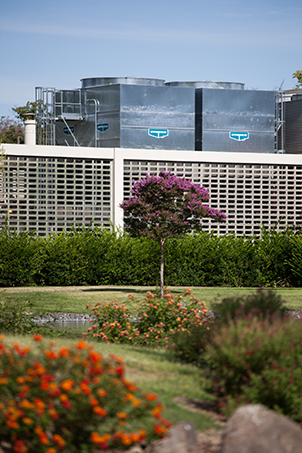Capital Planning & Facilities Management operates and maintains the computerized central energy management system for the campus ensuring that the university is operating in a manner that minimizes energy consumption as outlined in California State University Policy. The primary function of the system is to provide energy consumption savings while providing a comfortable environment for students, faculty, and staff.
System Dashboard: Systemwide Energy Companion Report | CSU (calstate.edu) to view energy, water and carbon measures.
Since 2007/2008, the campus’ electrical usage, measured in kWh/gross ft.2, has decreased by 12%. During the same time period, therms (the quantity of heat that’s needed to raise the temperature of 1 lb. of water by 1oF. per gross ft.2) were reduced by 37%. Combined, these reductions in energy use equate to annual savings of approximately $200,000 and $92,000, respectively.

Energy Upgrades
- Replacement of lights in Parking Lot 2 with LEDs that reduce energy consumption by 70%.
- Conversion to a sophisticated, high-speed, web-based energy management system (EMS), allowing a wider range of control and higher level of efficiency for the Heating, Ventilation, and Air Conditioning (HVAC) system and control of the campus reclaimed water system.
- Installation of a large photovoltaic system on the roof of the renovated Science I Building that generates enough energy to provide electricity to 58 homes per year and supplies energy for all of the electrical needs of the building excluding the HVAC system.
- Replacement of two cooling towers in the Central Plant, at the end of their service life in 2014, with new, high efficiency cooling towers that provide HVAC for most of the buildings on campus.

- Installation of a photovoltaic system to support the campus irrigation pump station.
- Fume hood exhaust improvements on the third floor of Naraghi Hall of Science involving a retrofit of the original, high volume ventilation system to a system that reduces flows through fume hoods to the lowest allowable levels. This project reduces overall average ventilation energy requirements by 50 to 60% and provides an annual energy savings of 440,146 kWh and 14,213 therms.
- Retrofit of the Central Plant MBx to optimize the performance of the campus chilled and hot water distribution systems, and chiller plants, to address operational issues with the goal of reducing energy usage. Major piping modifications and control strategies resulted in an annual energy savings of 213,998 kWh (24% of total).
- Maintenance of the HVAC temperature settings at 68 degrees in winter and 78 degrees in summer.
- Improvements in classroom scheduling of Summer and Winter Intercession classes to allow shut-down of the HVAC system in some buildings and zones during low-use periods.
- Conversion to a sophisticated, high-speed, web-based energy management system (EMS), allowing a wider range of control and higher level of efficiency for the Heating, Ventilation, and Air Conditioning (HVAC) system, and control of the campus reclaimed water system.
- Installation of a large photovoltaic system on the Main Dining building roof in 2018, estimated to generate enough power for the electrical needs of the building with the exception of the HVAC system.
- Retrofit of existing parking lot and pathway lighting with new LED fixtures in 2019, estimated to reduce energy consumption by 65%.
When replacing or repairing less efficient or damaged equipment, Facilities personnel apply the latest building techniques and technologies to reduce energy consumption. This includes motion sensors that turn off lights when rooms are unoccupied; lamps and ballasts to replace existing lighting as economically feasible and appropriate; maintaining temperatures within certain parameters; and turning off heating and cooling systems after hours.
Updated: October 23, 2024